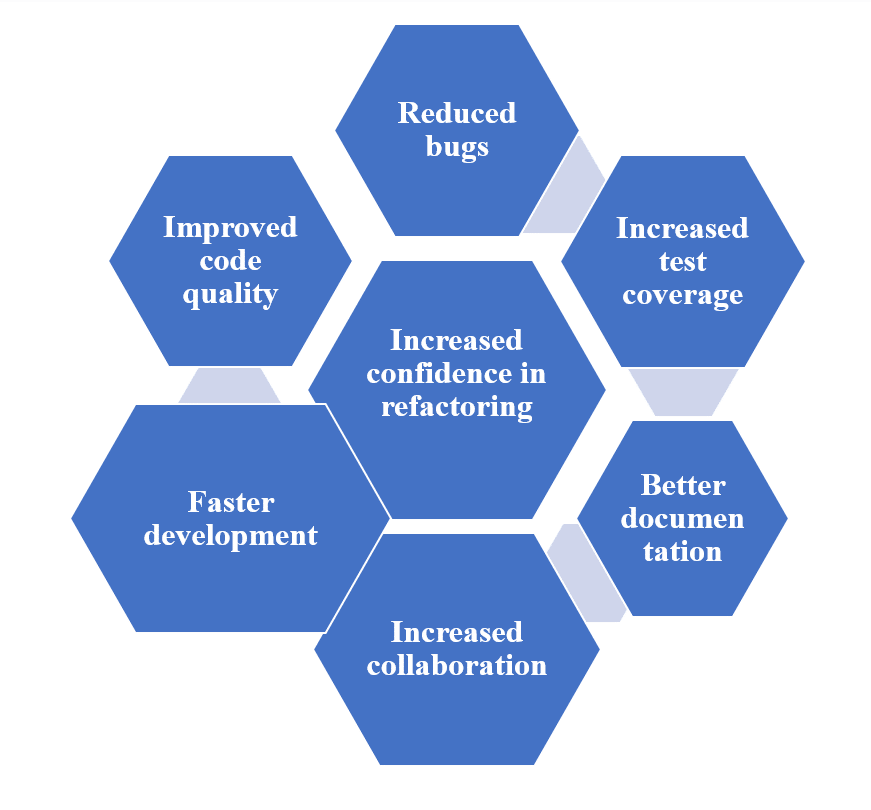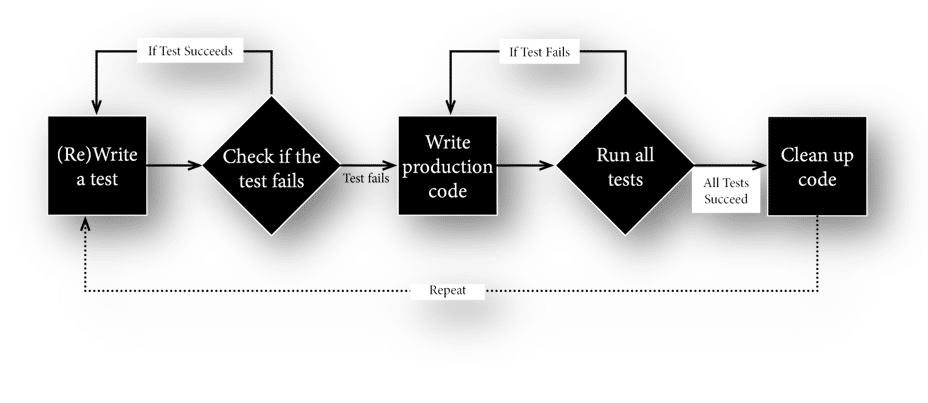Test-Driven Development: An Overview and Best Practices
This process helps to ensure that the code is correct and that any new changes do not break existing functionality. TDD also helps to improve the design of the code and makes it more maintainable.
It is an Agile methodology that is widely used in software development, particularly in the field of software engineering. TDD reduces the number of bugs in production and improves code quality.
For more information about TDD and its roles in mobile app development – check out the below article.
What is Test-Driven Development (TDD)?
During the development process, TDD ensures that the code is thoroughly tested and that any bugs are caught early on. Adding new features to the code generates new tests iteratively.
As the tests define the desired behavior of the code, the developer writes the code to pass the tests. Now, companies are focusing on the adoption of AI-enabled testing as compared to manual testing.
Comparison between Automation-Enabled Testing vs Manual Testing

| Difference | Automated Testing | Manual Testing |
| Testers | Automated testing is done using software tools. | While it is done by human testers. |
| Time | Testing can be run repeatedly and quickly. It helps in commencing time-saving operations. | It takes longer and is prone to human errors. |
| Coverage | Automated tests can cover a wider range of scenarios and edge cases. | It is limited to what the tester can think of and execute. |
| Expensive | Automated testing can be more expensive to set up initially. | It is generally less expensive in the short term. |
| Alignment | It can be run in parallel. | It is typically conducted sequentially. |
| Functional requirements | It can be used to test non-functional requirements. | It can be used to test non-functional requirements. |
Conclusion Driven from the above table
Clearly, automated testing should be given a higher priority than manual testing. During the mobile app development process, it is important to decide whether the testing will be conducted manually or automatically.
However, automated testing is not a cost-effective approach but investing in automated testing will be beneficial for organizations. Automated testing can eliminate the entire probability for any human errors.
Scaling TDD & Agile Model-Driven Development
Test-Driven Development (TDD) and Agile Model-Driven Development (AMDD) are both Agile methodologies. However, they differ in how they approach software development.
Scaling TDD:
- TDD focuses on writing automated tests before writing the actual implementation. It helps to ensure that the code is correct and that new changes do not break existing functionality.
- Scaling TDD requires a high level of test coverage and a culture of continuous testing. To maintain the quality of the codebase as it grows in size and complexity.
- Scaling TDD can be challenging, as it requires a high level of discipline and commitment to the process.
Scaling Agile Model-Driven Development (AMDD):
- AMDD is an Agile methodology that focuses on iteratively building models of the system and it uses a collaborative approach.
- Scaling AMDD requires a high level of collaboration and communication between team members and it focuses on continuous improvement.
- Scaling AMDD can be challenging, as it requires a high level of discipline and commitment to the process.
- However, TDD focuses on the testing-first approach and AMDD focuses on the modeling-first approach.
7 Key Benefits for TDD

1. Improved code quality
By writing automated tests before writing the actual implementation, developers are forced to think about how the code should work and how it should be used, which leads to better-designed, more robust, and more maintainable code.
2. Reduced bugs
Developers can catch bugs and errors early in the development cycle before they become difficult and expensive to fix. Always conduct 3-5 stages software testing.
3. Increased confidence in refactoring
With a comprehensive suite of automated tests in place, developers can make changes to the code with confidence.
4. Increased test coverage
During the TDD, it increases the test occurrence for testing all the code bases. It helps in the development of the
5. Faster development
With TDD, developers can make changes to the code more quickly, since they don’t have to manually test the code after making changes.
6. Increased collaboration
TDD process increases the collaboration among different departments – such as: QA managers, product mangers as well as other team members. All the members tend to work closely with each other during the TDD to ensure that all the bugs or errors can be rectified at the early stage.
7. Better documentation
Automated tests serve as living documentation for the codebase, providing a clear and up-to-date picture of how the code works and how it should be used.
Read more: Automation Testing Process: Ways To Calculate The Cost & Expected ROI
Steps To Develop the TDD

Test-Driven Development (TDD) is a software development process that follows a specific workflow, usually referred to as the “Red-Green-Refactor” cycle. The process typically involves the following steps:
Step 1: Write a test
Write a test case that describes the desired behavior of the code. This test should fail initially since the code does not yet exist.
Writing tests for Test-Driven Development (TDD) is an important step in the software development process. Here are some general guidelines for writing effective tests:
- Understand the requirements: Before writing a test, make sure you have a clear understanding of the requirements for the feature or functionality that you are testing. This will help ensure that the tests are comprehensive and accurate.
- Write one test at a time: Focus on writing one test at a time, rather than trying to write all the tests for a feature or functionality at once. This will help keep the tests simple and easy to understand.
- Use clear and descriptive names: Give your tests clear and descriptive names that accurately describe the functionality that they are testing. This will help make the tests easy to understand and maintain.
- Use assert statements: Use assert statements to check that the code is behaving as expected.
Step 2: Run the tests
Run all the tests to ensure that the new code passes the test written in step 1 and all other tests. Run all tests, not just the test for the feature or functionality that you have recently changed. This will help ensure that the new code does not break any existing functionality.
Use a testing framework that is appropriate for the programming language and framework that you are using. This will help automate the process of running tests and make it easier to integrate with the development process.
This will help catch any issues early in the development process and ensure that the code is always in a releasable state. You can even take use of additional tools to keep the tests into a releasable state.
Although, for running the code successfully you can connect with the best mobile app development company.
Step 3: Refactor
It is the process of cleaning up and reorganizing the code, making sure not to change its behavior. The goal of refactoring is to improve the design and maintainability of the code while ensuring that the tests continue to pass.
Refactor the code to make it simpler and easier to understand. Avoid adding unnecessary complexity to the code. Make sure the tests are simple and easy to understand. Avoid writing complex and convoluted tests, as they are harder to maintain and understand.
Refactor the code to follow the SOLID principles, which are guidelines for designing classes and objects. SOLID stands for Single Responsibility, Open-closed, Liskov Substitution, Interface Segregation and Dependency Inversion.
Step 4: Repeat
Repeat the process for each new feature or requirement, building up a suite of tests that cover the functionality of the entire system. Refactor the code regularly to improve its design and maintainability. This will help make the code simpler, more reusable, and more testable.
Step 5: Implement Continuous Integration (CI)
Implementing Continuous Integration (CI) is an important step in the Test-Driven Development (TDD) process. CI is a software development practice that involves automatically building, testing, and deploying code changes.
Here are some general guidelines for implementing CI with TDD:
- Use a CI tool: Use a CI tool, such as Jenkins, Travis CI, or CircleCI, that can automatically build, test, and deploy code changes.
- Automate the build process: rebuilding and redeployment of the code become easy. This will help ensure that the code is always in a releasable state.
- Automate the test process: run the codes with the automation testing tools because it will reduce into testing and identifying bugs. This will help catch any issues early in the development process.
- Automated development: It is important to understand that the process for automated testing is highly helpful in reducing bugs and errors. Although, this testing is not a cost-effective approach as compared to the mannual testing methods.
Additionally, it’s a good practice to have a clear understanding of the requirements and design of the code before starting to write the tests, to ensure that the tests are comprehensive and accurate.
Read more: Understanding Software Maintenance and Support: What it is and Why it Matters?
The Final Words
To attain optimum client satisfaction, it is important to courage the process of continuous testing. As continuous testing will help the company to effectively improve their client’s project. Test-driven development also minimizes the probability of getting bugs at the final stage.



 sales@amplework.com
sales@amplework.com
 (+91) 9636-962-228
(+91) 9636-962-228





